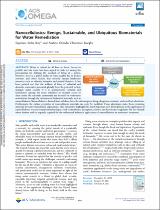 ResearchSpace
ResearchSpace
Nanocellulosics: Benign, sustainable, and ubiquitous biomaterials for water remediation
JavaScript is disabled for your browser. Some features of this site may not work without it.
- ResearchSpace
- →
- Research Publications/Outputs
- →
- Journal Articles
- →
- View Item
| dc.contributor.author |
Ray, Suprakas S

|
|
| dc.contributor.author |
Irougbu, AOC

|
|
| dc.date.accessioned | 2021-04-23T10:11:03Z | |
| dc.date.available | 2021-04-23T10:11:03Z | |
| dc.date.issued | 2021-02 | |
| dc.identifier.citation | Ray, S.S. & Irougbu, A. 2021. Nanocellulosics: Benign, sustainable, and ubiquitous biomaterials for water remediation. <i>ACS Omega, 6(7).</i> http://hdl.handle.net/10204/11992 | en_ZA |
| dc.identifier.issn | 2470-1343 | |
| dc.identifier.uri | DOI: 10.1021/acsomega.0c06070 | |
| dc.identifier.uri | http://hdl.handle.net/10204/11992 | |
| dc.description.abstract | Water is critical for all lives to thrive. Access to potable and safe water has been argued to rank top among the prerequisites for defining the standard of living of a nation. However, there is a global decline in water quality due to human activities and other factors that severely impact freshwater resources such as saltwater intrusion and natural disasters. It has been pointed out that the millions of liters of industrial and domestic wastewater generated globally have the potential to help mitigate water scarcity if it is appropriately captured and remediated. Among the many initiatives to increase access to clean water, the scientific community has focused on wastewater remediation through the utilization of bioderived materials, such as nanocellulosics. Nanocellulosics, derived from cellulose, have the advantages of being ubiquitous, nontoxic, and excellent adsorbents. Furthermore, the surface properties of nanocellulosic materials can easily be modified. These advantages make them promising materials for water remediation applications. This perspective highlights the most important new developments in the application of nanocellulosics in water treatment technologies, such as membrane, adsorption, sensors, and flocculants/coagulants. We also identify where further work is urgently required for the widespread industrial application of nanocellulosics in wastewater treatment. | en_US |
| dc.format | Fulltext | en_US |
| dc.language.iso | en | en_US |
| dc.relation.uri | https://pubmed.ncbi.nlm.nih.gov/33644559/ | en_US |
| dc.relation.uri | https://pubs.acs.org/doi/pdf/10.1021/acsomega.0c06070 | en_US |
| dc.source | ACS Omega, 6(7) | en_US |
| dc.subject | Freshwater resources | en_US |
| dc.subject | Nanocellulosics | en_US |
| dc.subject | Water remediation applications | en_US |
| dc.subject | Wastewater remediation | en_US |
| dc.title | Nanocellulosics: Benign, sustainable, and ubiquitous biomaterials for water remediation | en_US |
| dc.type | Article | en_US |
| dc.description.pages | 4511-4526 | en_US |
| dc.description.note | This is an open access article published under an ACS AuthorChoice License, which permits copying and redistribution of the article or any adaptations for non-commercial purposes. | en_US |
| dc.description.cluster | Chemicals | en_US |
| dc.description.impactarea | Nano | en_US |
| dc.identifier.apacitation | Ray, S. S., & Irougbu, A. (2021). Nanocellulosics: Benign, sustainable, and ubiquitous biomaterials for water remediation. <i>ACS Omega, 6(7)</i>, http://hdl.handle.net/10204/11992 | en_ZA |
| dc.identifier.chicagocitation | Ray, Suprakas S, and AOC Irougbu "Nanocellulosics: Benign, sustainable, and ubiquitous biomaterials for water remediation." <i>ACS Omega, 6(7)</i> (2021) http://hdl.handle.net/10204/11992 | en_ZA |
| dc.identifier.vancouvercitation | Ray SS, Irougbu A. Nanocellulosics: Benign, sustainable, and ubiquitous biomaterials for water remediation. ACS Omega, 6(7). 2021; http://hdl.handle.net/10204/11992. | en_ZA |
| dc.identifier.ris | TY - Article AU - Ray, Suprakas S AU - Irougbu, AOC AB - Water is critical for all lives to thrive. Access to potable and safe water has been argued to rank top among the prerequisites for defining the standard of living of a nation. However, there is a global decline in water quality due to human activities and other factors that severely impact freshwater resources such as saltwater intrusion and natural disasters. It has been pointed out that the millions of liters of industrial and domestic wastewater generated globally have the potential to help mitigate water scarcity if it is appropriately captured and remediated. Among the many initiatives to increase access to clean water, the scientific community has focused on wastewater remediation through the utilization of bioderived materials, such as nanocellulosics. Nanocellulosics, derived from cellulose, have the advantages of being ubiquitous, nontoxic, and excellent adsorbents. Furthermore, the surface properties of nanocellulosic materials can easily be modified. These advantages make them promising materials for water remediation applications. This perspective highlights the most important new developments in the application of nanocellulosics in water treatment technologies, such as membrane, adsorption, sensors, and flocculants/coagulants. We also identify where further work is urgently required for the widespread industrial application of nanocellulosics in wastewater treatment. DA - 2021-02 DB - ResearchSpace DP - CSIR J1 - ACS Omega, 6(7) KW - Freshwater resources KW - Nanocellulosics KW - Water remediation applications KW - Wastewater remediation LK - https://researchspace.csir.co.za PY - 2021 SM - 2470-1343 T1 - Nanocellulosics: Benign, sustainable, and ubiquitous biomaterials for water remediation TI - Nanocellulosics: Benign, sustainable, and ubiquitous biomaterials for water remediation UR - http://hdl.handle.net/10204/11992 ER - | en_ZA |
| dc.identifier.worklist | 24463 | en_US |





